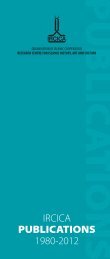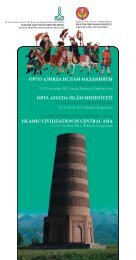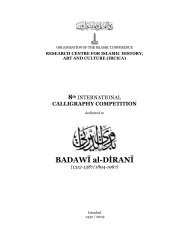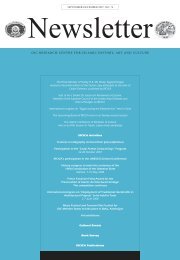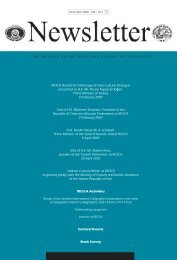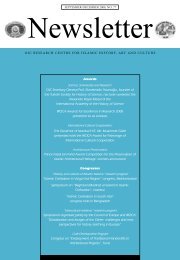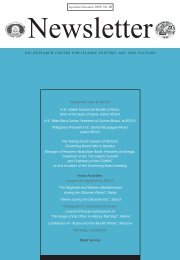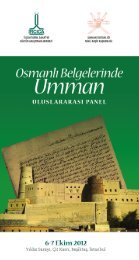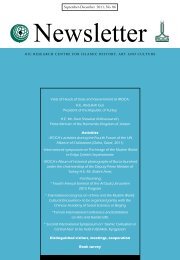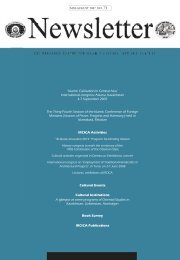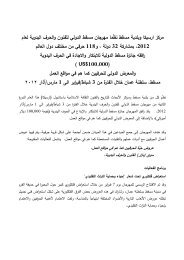hlights o - ircica
hlights o - ircica
hlights o - ircica
- No tags were found...
Create successful ePaper yourself
Turn your PDF publications into a flip-book with our unique Google optimized e-Paper software.
On the Occasion of Celebrating Doha-Capital of ArabCultureHig<strong>hlights</strong> of theDoha Internatioonal Handicrafts Festival FAccompaniedby:International Seminar onInnovation and Creativity in Crafts7-9 December, 2010Doha InternationalAward for Innovation and Creativity in Craftsand the International Exhibitionof Artisans-as at-WorkDoha, Qatar, on 5-9 December 2010Within the framework of celebration of Doha, capital of Arab culture for r 2010, the Ministryof Culture, Arts and Heritage in the State of Qatar and the Research Centre for History, Artand Islamic Culture in Istanbul organizedd in Doha Grand the Doha D International Festival forHandicrafts, whichh was accompaniedby an InternationalSeminar onn "Innovation andCreativity in Crafts"; "Doha Internationall Award forInnovationn and Creativity in Crafts"; andthe International Exhibition off Artisans-as at-work.The works of the symposiumm and the festival weree inaugurated by His ExcellencyProf. /Mubarak bin Nasser AI-Khalifa, Secretary General of the Ministry of f Culture, Arts and2
Heritage, and Dr. Halit Eren, Director General of the Research Centre for History, Art andIslamic Culture in Istanbul (IRCICA), in the presence of some OIC Ambassadors representedin Doha.His Excellency Prof. / Mubarak bin Nasser AI-Khalifa stated in his address that crafts isconsidered as a first priority within the Cultural Strategy of the State of Qatar. He added thatcrafts images the national identity and contribute towards the introductionn of the cultures ofother people. Thiscan easily be noticed through this international festivall where artisans andexperts from different places of the world are coming together to exchange expertise andwork with the same spirit of giving love and creativity to this field. f He also pointedout thatcrafts are a mean toface jobless difficulties and he called for thee community to recognize wellthe importance roleof the artisans for thee society.Dr. Halit Eren, Director General of the Research Centre for History, Art and Islamic Culturein Istanbul (IRCICA),Dr Halit Eren pointed out theimportance of organizing this festival f in Doha and gatheringMaster Artisans from various regions to display their innovative works and meet withspecialists of the field. He added that the festival aimed to raise more awareness off the realrole played by crafts towardss contributing economically and culturally c too our communities.He gavea brief about the various eventss IRCICA organized before b with the same spirit andreferredto the Craft books that t were published onvarious specialized s topics. Finally heexpressed his gratitude to the Ministry off Culture, Arts and Heritage of thee state of Qatar andits cadrefor the warm hospitality and the organizing efforts of this important event.3
The Closing Ceremony was inauguratedd by HE Dr Hamad bin Abdul Aziz Al-Kawari,Minister of Culture, Arts and Heritage who honoured the artisans and met with theArtisanss at their stands and had talks withh the Paper presenters as a well.The festival aimedat gathering all the innovators and craftspeople in this field in pavilionsforminga craft village where they t will display their works, their tools and the techniques usedin their workshops; Only 12 selected artisans are invited to this exhibition from differentcountries along with some Qatari Artisans.International Seminar on Innovation and Creativity in Crafts, 7-9 December, 2010The seminar organized in order to raise internationalawarenesss of the importance of crafts; toexplore the economic role that these products canplay; to discuss d ways of exploring jobopportunities for citizens in this sector; too try to activate innovation and creativity spirit in thisfield; toexamine the revenuess that this sector can generate when linked with the touristic andeconomic sector; to examine the currentt situation of the craftss and the perspectivesof theirdevelopment; to preserve the originality of the traditional crafts; and to introduce the sectorand make it known through the t available channels. 11 papers were presented by selectedCraft Specialists from around the world including two specialists from Qatar.Dr. Halit Eren, Director Generall of IRCICAis presenting a Turkish Vase toHE Dr Hamad bin Abdul Aziz Al-Kawari, Minister of Culture, Arts and Heritage4
The seminar deliberated on thefollowingg themes:1 - General theme: Crafts: past, present and future,2 - Crafts from the perspective of heritage and culture,3 - Crafts from the perspective of economy and tourism,4 - The size of employed labor in the field of crafts, and its economic returns,5 – Perspectivesof handicrafts marketing,6 - The role of crafts in introducing thee cultural heritage identity and make it known,7 - The role of crafts in the cultural dialogue among peoples,8 - The relationship of craftss with the habits and traditions of the region,9 - The impact of crafts on European art,10 – Patronage andGovernmental Efforts in developing and protecting crafts,11 - Training and education opportunitiees in this sector,12 - Means that guarantee theincrease of public awareness of the importance of artisans andthis heritage,13 - Audio-visualmedia and their responsibility in forming a generation g consciousness of theimportance of handicrafts,14 - Educational programs for children and their role in forming a generation awareness ofthe importance of crafts and heritage.Inauguration of the Artisans ExhibitionThe seminar examined, among others, crafts of thepast, present and future, under cultural,economic and touristic perspective and their role in the cultural dialogue between peoples,and the relationship of these arts with the habits and traditions of this region. It also dealtwith thequestion of the size of the laborr employed in this sector and its economic revenues,5
the perspectives of marketing, the efforts of theGovernment in thee development andpreservation of crafts, and training and educational opportunities in this sector.Visiting thee Stands of the ArtisanssThe seminar aimedat the following objectives: Revitalizing the economicc and cultural sector by providing the visitors and participantswiththe opportunity of getting acquainted withthe masterworks of crafts as well as thecharacteristics of creativityand innovation in thisarea. Organizing competitive programs for young artisans to urge themm to express moreinnovation andcreativityin the field of crafts; also honoring them with awards toencourage their participation in such activities to achieve and perform distinguishedmasterworks all the time. Evaluating the present situation of crafts and employing them in the economic field, anddetermining a framework for f the development oftheir cultural and social aspects. Discussing the measures that t can be taken to avoid the loss of valuess and traditions thatcharacterize crafts, with a view to preserving thespecial nature of thiss artisanal aspect ofthe heritage. Issuing an academic document resulting from the presentedd papers, which will be usefulto the specialized organss in the Member States, to fill up the gaps in this area andpublishing the papers of the seminar in a book documenting crafts as a reference forexperts and scholars in thiss field, Developing a strategy for internationaial cooperation in this sector.6
1 st Session of the seminar7
The participantsin the symposiumincluded representatives of some internationalorganizations, centers and specialized institutions and crafts experts, and d dealt with culturaland heritage aspects, study means of goodd employment for the handicraft h sector and exploringreturns provided by this vital sector, leading to maintaining their traditional originality, andpromoting crafts within the available channels.Dr. . Naseer ArafatProf. Jasleen Dhamija8
Al Jazira Logo presented to HE Dr Hamad bin Abdul Aziz Al-Kawari, Arafat, Palestine Minister of Culture,Arts andHeritage by Dr. Naseer PPartt of the sessions9
HE Dr Hamad binAbdul Aziz Al-Kawari, Ministerof Culture, , Arts and Heritage along withDr. Halit Eren, DG of IRCICA and d Mr. Hamadal-Muhanadi, Director of HeritageDirectorate, State of Qatar,Qatari innovation in windows and gyps10
Mr. Hamad al-Muhanadi, Director of Heritage, Ministry of Culture, Arts and Heritage, Qataralong with Dr. Redoune Laroussi who presents his paperThe 12papers presented inthe symposium resulted in aincluding:number off recommendationsFirst: The symposium delegated HE Dr Hamad bin Abdul Aziz Al-Kawari, Minister ofCulture,Arts and Heritage to send a cable of thankson their behalf to the Emir of Qatar, HisHighness Sheikh Hamad bin Khalifa AI-Thani, expressing deepp thanks andd great appreciationfor the excellent organizationand warm welcome extended to the participants on the occasionof this event.Second: Search for opportunities to provide raw materials locally.The seminar emphasized theimportance of moresurvey research forr opportunities thatguarantee providing raw materials locally, which artisans need so that they can get rid ofdependence on theimport of some whichh affect theprice of the product, and to recommendthe establishment of local associations concerned with the supply of raw materials and exportthe product and improve the configurationn to supportproductivee families.11
The seminar also stressed the fact that requirementsof the consumer must also be mett throughproduct t development, and bydoing studies related to aesthetics that meet consumer andmarket requirement, and theuse of heritage as a source of inspiration, research andinnovation. This is in additionto the needd for growthand development of traditional productsthroughh the application of standards for quality control, and printing p of the approved label,packaging and preparation inline with market competition to t win the satisfactionof theconsumer, and finally one of the prioritiess of the institutions is to t enter neww markets.Third: consumer educationThe seminar pointed out the importance of the issue raising awareness of the role ofhandicrafts and it places on the t literal and stakeholders working in this field, in a way thatencouraged the developmentt of the appropriate steps aimedd at consumer education andawareness of the advantages for this sector.Fourth: EducationProgramsThe meeting discussed the issue of the need of education by linking the literal to educationalinstitution, or to link the workshop craft service to learning at all levels of the educational tothe stage of further education, which provides for the craftsman or craft, , the opportunity toconfigure the general culture around the craft, and some of the basics of design anddevelopment skills, and improve productt quality and marketing methods, , and issuess dealingwith the consumer, all of which contribute to the development of employability andqualifications, anda climate of innovation. University studies and to encourage scientific sstudies interested in the concepts and dimensions ofthe cultural, artistic and aesthetic valuesof handicrafts.12
Participants at one of the sessions13
Parts of thee Stands of the Artisans14
HE Dr Hamad binAbdul Aziz Al-Kawari, Ministerof Culture, , Arts and Heritage along withDr. Halit Eren, DG of IRCICA honoringArtisan Mahdi Heideri, IranHE Dr Hamad binAbdul Aziz Al-Kuwari, Ministerof Culture, , Arts and Heritage along withDr. Halit Eren, DG off IRCICA honouring Artisan Hikmet Barutcugil, Turkey15
ArtisanAslihan Nihan Guney, Turkey showing her technique of workFifth: TrainingThe seminar pointed out the urgent needd to developtraining programs integrated forr artisansto strengthen and upgrade their qualifications, and to develop scientific training programs incoordination with all actors and the usee of all types of configuration possible, and adaptmoderntechnologyin the fields of materials, design,information, tools andd pricing, costs, andtax issues and other, which helps in the developmentof productivity and raise the value of theproperty.Sixth: Exchange of techniques and expertise usedWork on the exchange of visits between the craftsmen of the Member States, in order to getacquainted with the methods developed in each country, and techniques applied, thereby toenrich the expertisee of each off them.17
Mr. Hamad al-Muhanadi, Director of Heritage Directorate, State of Qatar in the middle withsome of the participated artisans,18
Mr. Mohammad Saeed al-Blouchi and Prof. Jasleen DhamijaSeventh: InnovationTaking necessary measures to ensure the innovation,research, training andd organization of theliteral, and to maintain the continuity of a pattern of innovation.Eighth:Documentation and StudiesAttention to documentation for all types of craft products and techniques, as well as exhibitingin the museums and exhibitions of the Islamic world, providing forr the formation ofinformation about the data for various types of handicrafts.Ninth: FinanceThe seminar highlighted the issue of funding, its availabilityand how too access it, are keyelements plaguing the sector including i the absence of policy identified consistently to ensuresecurity. This calls Member States and funding agencies in the privatee sector to work toprovide funds to support projects, crafts, and to provide needed capabilities to the sector s tocontinuein the process of creativity and innovation that is the basis for giving in theIslamicCulturall Heritage.Tenth: Role of thegovernment for extending patronage for the t crafts sectorAttention and carefor artisans to find their placewithin the rival groups. This calls forrestructuring traditional industries in all countries ofthe Islamicc world within an organizationand the national professionaland officiall work on policies promoting the sector, andclosingthe ranks of its employees.19
At the stand of the Algerian Artisan Mohamed al-Sayis sEleventh: Participation in international exhibitionsAttention to the inclusion off villages' productivityand handicraft shopss selling traditionalproducts.Twelfth: The search for newmarketingg opportunitiesThe need to provide effective coordination of efforts and exchange of experiencess amongMemberStates, and develop a strategy for international cooperation in thee future in this field,throughh the delivery of qualitative studies on the evolution off demand and supply, and thechanging tastes ofconsumerss in the global market,and to open new avenues for marketingbased onnew.Thirteenth: Tourist market and the establishment of craft villagesAttention to the establishmentt of craft villages that can be linked to the tourist sector, , and theuse of some of the monuments or historical sites eligible to receive the tourist activity, whilemaintaining the identity of urban crafts related to the architecture and decoration andornamentation.Fourteenth: LegalprotectionThe need to take some actions aimed at the type oflegislationn of laws to protect intellectualself-craftsmen, including completed products, including designss and others.Fifteenth: Globalization andthe role off media in awareness::20
Determine the responsibility of the mediaa goes handin hand with the efforts of the literal, thearchitect and designer, in the promotion of artisanal sector, andd to make itt and its importanceat all local, regional and international levels.Palestinian StandSixteenth: AwardsAttention to monitoring of awards for scientific studies and documentation work, innovationand good products in the traditional industrial sector. Ensure thee organization of exhibitions atthe local, regional or international arena, and the payment of artisans to deal with it seriously sand participate. Excellent products should be prepared before the craftsmen of otherinstitutions and States to ensure competitive status, as well as innovation and continuinglegacy in a spirit ofrenewed professionalism.21
Stand of the Qatari Artisan Suad IbrahimAbstracts of thePresented Papers:Arts and Craftsfrom thePerspective of Economy and a Tourism,Indrasen Vencatachellum2The economic andsocial importance off arts and crafts has been b voicedd in all parts of theworld by the promoters of this sector during decades. However, their voice has not generallybeen heard by decision makers and funding agencies because, among other reasons, thisimportance is not easy to demonstrate with facts andfigures.Likewise, the linkage betweencrafts and tourism has not always been fullyy taken into accountin development strategies owing to a simplistic approach in which tourism m is qualified, at best, as an “angel” providing a source of income for artisans or ,at worst, as a “devil” destroyingthe creativity and culture of these artisans. What are then the prospects for a better recognitionof the economic role of craftss and for the development of mutually beneficial links betweencrafts and tourism?2Coordinator, Internationall Network for Craft Developmennt- RIDA. From 1988 to 2008,Director of UNESCO’s Programme for the promotion of craftss and design. He has initiated thefirst ‘Ten Year Plan of Action for Crafts Development in the World’, launched the “UNESCOCrafts Prize” for Africa, Asia, the Arab States and Latin America followed by the SEAL ofExcellence; prepared skillss upgrading workshops in several sub-regions and organizedmeetingofexperts ( “ Crafts and Tourism; Codification of craft products; Lead-free ceramics; naturaldyes international symposium and workshop...) as well as a series of exhibitions ( “Crafts fromaround the world”, “DESIGN 21”...)23
I submit that thesee prospects are many iff we consider, on the one o hand, recent trends withinthe tourism sectorand, on the other hand, the growing awareness of the socio-economicimpact of crafts on sustainable development and poverty eradication. Strangely enough, itappears that the current worldeconomic and financial crisis as well as thee global concern forthe environment are providingan added support to these trends. Thus, the Financial Times, inits issueof 14 March 2009, devoted ann extensive article “Crafted withh care” in praise ofartisan products from developing countries and of a “genuine blossoming of interest intraditional skills and materials”.Besides, there exist some interesting experiments worldwide inn crafts promotion forr touristsand in the collection of data to demonstrate the economic and social importance of crafts.These case studies can serve as useful references for other interested countries.Indeed, the defensee and promotion of the cultural and socio-economic dimension of crafts callfor continuous demonstrations with facts and figures. Tourism, with itss opportunities andchallenges represent an ideal platform forr sensitizingall stakeholders- local, regional, nationaland international; private andpublic- onn the need to support crafts c for the benefits of hugecommunities of artisans.24
ArtisanHikmmet Barutcugil, TurkeyyDr. Naoto Suzuki, Japan, presenting his paper25
An Educational Programme Aiming at Restoration of a Traditional Playground andBamboo Crafts and Toys for Children, Naoto Suzuki 3“Hometown designer”, as a profession, let alone as a terminology, has yet to fully bloom andbecome recognized in Japan. One of the academic programs offered by Chiba University inIsumi City, Chiba Prefecture, intends to focus on restoration of Satoyama- bush hills located notfar from the residential areas through promoting traditional bamboo crafts making amongchildren, coupled with cleaning/cutting bamboo for space making and making playing toys. Theprogram offers an opportunity for students to work closely with children and parents to improvetheir design and implementation capacities as well as for the parents to take initiatives forcontinuation of this educational program for their children. Rhetorically connoting a medicalprescription written by a home doctor to treat an illness, the academic program on “designing aliving” reflects a careful diagnosis of the drastic changes to the cultural, social, environmental,and economic conditions particular to a region or town and the solutions thereof. With thisacting as a rubric or new perception of a specialist’s role, the paper analyzes the basicapproaches that a specialist should apply and the key factors that assure sustainable educationalprograms for the children who will act as a driving force to pass down our traditional arts andcrafts to the next generations. Specifically, these refer to the academic program’s features onidentifying indigenous resources (treasures), identifying and screening nonproblem-solving–based ideas, and formulating future visions.The paper firstly presents the features of the program implementation and the lessons learned.The headings of the lessons learned are as follows (1) Sharpened Sense of ResourceIdentification through Role Playing, (2) Correlation between Degree of Participation andSustainability, (3) Functioning Non-problem Identification Approach, (4) Comprehension onHare (state of nondaily-life) and Ke (state of ongoing daily life) for Craft MakingSecondly, it presents the proper evaluation methodologies for children’s educational programsemploying cultural resources. When designing a living aims to enhance children’s awarenesstoward tradition in the above mentioned approach, its sustainability should not be assessed ineconomic terms. Rather, it should be assessed through various social perspectives and reviewedfrom various macro perspectives as well as from micro design functions, which are closelyrelated to cultural elements. Besides these perspectives, the nature and magnitude of the designgoal should be integral criteria in the critical assessment of the rationality of the proposed“designing a living” program. The author intends to show that the children’s educationalprogram can be further improved through the activation of positive social linkages andexchanges within the local population. The paper thus analyzes the sustainability of this3Ph.D., Regional Development, Graduate School of Science and Technology, Chiba University.Professor, Design Culture Unit, Design Science, Graduate School of Engineering, ChibaUniversity. Senior Industrial Development Officer, Private Sector Development Branch/IPC,United Nations Industrial Development Organization (UNIDO), Vienna, Austria (1978- 2003).Consultant, Engineering Consulting Firms Association (ECFA), Tokyo, Japan (1975-1978).Presented various technical papers among them: “Effective Regional Development throughArtisan Craft Promotion”- 178 pages, May 2005; “Promotion of Artisan Crafts toward Creation ofWealth and Reducing Poverty”, submitted to Research Center for Islamic History, Art and Culture(IRCICA), International Congress on Islamic Arts and Crafts, Isfahan, October 2002;“Development Strategies for Small and Medium Enterprises (SMEs)”, Gulf Organization forIndustrial Consulting (GOIC), May 2001. Among his presented lectures: “Japanese Experience inSME development and Investment Promotion”, February 2001, Tripoli, Libya; “DevelopmentPotential for Vietnamese Artisan Crafts”, March 2001, Ninh Binh Viet Nam; and “TraditionalCraft Development in Lao PDR”, November 2002, Vientiane, Lao PDR.26
educational program from three dimensions and lays down specific s evaluation guidelines.Evaluation for designing a living is a critical activityand is an integral function of hometowndesigners in their task. Learning the various features of evaluation is an indispensableskill thatshould be nurtured by such a specialist.The paper clearly specifies thekey areas and guidelines for designing a living, implementationand evaluation of children’s up-bringingg programs in restoring traditional playground withtraditional bambooo craft making. The paper strongly advocates the importance of the entiredesign process for children’s education.These guidelines may be of valuee for those who areassociated with preservation of traditionall culture and arts and crafts c such as policy makers ofthe regional and national governments ass well as the scholars who could mobilize universitystudentss for children’s educational programs in inheritance of traditional values andculturalactivities.The photos below show the feature of the program as an easy reference:Learning Bambooo as aDrawing Wishes forCutting Bamboo into MakingBambooValuableTraditionalTraditional SatoyamaPieces with a Help of CraftsandResourceRestorationParentsExhibitingKeywords:Hometown Designer for Children’sEducation, Restoration of a TraditionalPlayground, Bamboo Crafts, Sustainabiliity, Evaluation on Designing a Living for Children’sEducationHandicraft centers as a tool for revitalizing the t traditional artifactsindustry - The Fayoum Handicraft Network Initiative: I : An EgyptianExperience, Mohamed Elkhatib 4FayoumOasis in Egypt offers a glimpse into traditional Egyptian rural lifee style with rich andcomplexethnic cultural groups includingg farmers, Bedouins, and fishermen living together inthe same region. This combination of local lifestyles has its related types of products andactivities such as: Cultural tours that may combinethe following type of activities: poetry,4Architect and Environmental planner. M.Sc.in environmental planning p from Cairo University.Founder and Managing Director of Environmental Design Groupp EDG, Egypt. Chairman of theScientific Institution for Environment and Development since 2006. Founder and Vice Presidentof Aquatech Company for tourism andd urban development S.A.E since 1997. Member of theconsulting committee for preparation of the strategic vision for Cairo C 2050, GOPP (September 08– present). Member of theNational Scientific Committee of UNISCO for preparation thedocuments of Gebel Qatrani to be nominated as an World Heritage Site (August 05 – August 06).Senior planner of the site management plan for the Pyramids Plateau, the archaeological area ofGizapyramids, Sphinx, andthe surrounded tombs, Ministry of culture, Supreme council ofAntiquities, Egypt 2002. Mr. El Khatib has Over 24years of professional experience in the fieldof vernacular architecture, ecotourism, and environmental planning. He hass worked extensivelyfor both public and private sector organizations local Egyptian and international agencies (USAID- GTZ - UNDP – Netherlands embassy – Italian Cooperation -DANIDA -EEAA - TDA).27
asketry, poetry recitation, traditional storytelling, traditional storytelling, falconry, falconryexhibitions, and traditional fishing. Many villages in Fayoum have unique traditionalhandicrafts expressive of the history and traditions of local people in Fayoum. The abundanceof palm trees and clay found in Fayoum are the reasons how the basketry and pottery industrybegan here. Some villages such as Nazla, and Tunis are master craft centers of pots andconsider open heritage museums that explains the culture, traditions, and many uses ofpottery.Significant decline in the production of crafts in Fayoum has taken place during the lastdecades. Due to the decrease in demand of the handicraft products, many of the crafts'producers have abandoned their profession. This led to the loss of many job opportunities inthe crafts. Crafts were also a part of the structure of society in some locations where thewhole family; children, women and old men practiced handicrafts. Most of craft producers arepoor, low skilled, and live in rural areas. They are increasingly marginalized due to the social,economical and cultural changes through the last decades. The Fayoum Handicraft NetworkInitiative is aiming to create hubs of crafts, cultural, artistic, and tourism centers as animportant resource to preserve the heritage of Fayoum. These centers will also adopt, educateand train many of boys, women, and artisans on the principles of craftsmanship legacy tomake distinct names of them in the field of handicrafts. The handicraft network will providetraining, outlets, and workshops for the local craftsmen. The main purpose of the FayoumHandicraft Network Initiative is to play the following roles:1. Generate visitations from the tour operators to these centers and encourage tourists torepeat their visits and support the development of a satisfying win-win relationshipbetween tourists and local craftsmen.2. Introduce the Fayoum handicraft products within its related culture, folklore, music,events, poetry contests, storytelling, and songs, etc in an open air festival piazza andamphitheatre to introduce the Fayoum events and activities to tourists.3. Provide market access in the area of handicrafts.4. Provide information and educational facilities that will result in greater understandingand appreciation for the Fayoum’s natural and cultural heritage, and inspire in localcommunity a new type of appreciation for their local culture and traditions by telling thehistory of the local handicraft products, culture, heritage, traditions, costumes, etc.Globalization and Crafts, Jasleen Dhamija 5In traditional societies crafts play an important role as means of employment and production,as well as a significant aspect of the creative expression of the community and a rich5Internationally renowned in the field of Living Cultural Traditions, Rural Non-Farm Developmentand History of Textiles and Costumes. She has worked in development of Handicrafts andHandlooms in India at the pioneering stage in the 50s. Continuing to work for the United Nationsin Iran, Central Asia, in 21 African countries, the Balkans, South Asia and South East Asia. Shewas also consultant to World Bank and International NGOs. She was awarded Hill Professor atthe University of Minnesota. She was a faculty member at the National Fashion Technology aswell as visiting faculty at the National Institute of Design in India and at 3 Universities inAustralia. She has authored several books on Textiles and Folk Arts, on Women’s Employment,Income Generation, organised seminars, curated exhibitions in India, and abroad. Did a majorexhibition on "Textiles of the Commonwealth" for the Games at Melbourne in 2006. In 2000 shecarried out an evaluation of UNESCO’s work in Crafts in the last decade and directions for thefuture. Was appointed President of Jury for UNESCO's Award for Creativity in Textiles, over thepast few years. She is Editor of one Volume of the World Encyclopedia of Dress and Fashion.President of International Festival of Sacred Arts, Delhi.28
epertoire of the indigenous skills. They are closely linked with their way of life and play animportant part in the rites of passage and the festivals, which enrich their lives. Many seeglobalization as a threat to the craft industry, however if globalization is effectively used toreach out to newer markets it cannot only create a larger market, but also increase the earningsof the craftsmen, who are often paid a pittance for the traditional objects. What is needed is asupportive government policy, which would work for the interest of the craft sector and notagainst it. It needs greater participation of the master craftsmen in policy making, as well asin creating protective measures and assistance in reaching out to global markets.The Hidden World of the Living Craft Tradition, Noorjehan Bilgrami 6Craftsmen in Swat produce the most powerfully primeval wood-carvings and a similarvocabulary continues on the textiles. At the foot of the Karakorums, is the Indus Kohistan -‘the land of mountains’ where costume is the vehicle for the finest embroidery.The Indus flows through the land of the five rivers, the Punjab, with its fertile lands. Alegendary granary since the time of Harappan culture, it is also home to the fabled city ofLahore, known for its exquisite hand embroidery with silver and gold thread, the zardozi,perfected by the Mughals, which still continues. Punjab is well known for its phulkaris, whichfollow a technique similar to those of Swat Valley and Hazara.In Sindh, the people have a deep reverence for the ajrak. From birth to marriage, until death,ajrak commemorates all significant events of the life cycle. The process of making an ajrak ishighly complex, comprising of 21 different stages of washing, dyeing and block printing.Khairpur, located in upper Sindh, is a place of great historical significance in thesubcontinent. Indigo was extensively cultivated and exported here, making Khairpur state thefourth largest exporter of indigo in the world. Khes, a traditional patterned bedspreadcommonly used in homes is a double-weave cloth, intricately woven with cotton or silk yarn.It was an acclaimed textile export item in the Moghul Period and was very popular inEngland.The variety, diversity and enormity of the traditional textiles of Pakistan is overwhelming.One vital thread common to all the traditional textiles is the involvement of the maker,whether it is purely at an individual level, or as part of a communal activity, shared by familyand friends. Each pair of hands has innocently embroidered or woven a part of its soul in thecloth. What is woven from the soul of one immediately reaches the heart of the other!Continuation of Local Knowledge - Methodology of the Reuse and theRevival of the Local Knowledge in Employing the Natural Resources inTraditional Crafts Industries, Kaltham Al Ghanim 76Artist, Designer and Researcher. Years of research into ajrak, a traditional Sindhi textile, led topublication of the book Sindh jo Ajrak, and later to the making of the documentary video, Sun,Fire, River, Ajrak -- Cloth from the soil of Sindh. Handloom weaving and natural dyes are nowher major interest and she was awarded the Japan Foundation Fellowship in 2001-02 to pursueresearch on natural indigo in Japan. Bilgrami curated the exhibition Tana Bana: The Woven Soulof Pakistan in collaboration with Jonathan Mark Kenoyer at the University of Wisconsin,Madison, in 1998; the exhibition later traveled to the Pacific Northwest College of Art, Portland,Oregon, the Pacific - Asia Museum, Pasadena, California and Mingeikan, the Japan Folk CraftMuseum, Tokyo. A comprehensive bilingual exhibition catalogue documenting the traditionaltextiles of Pakistan was produced in 2004 when the exhibition traveled to the prestigiousMingeikan. Traveled extensively and lectured at universities and museums in the United States,Scandinavia and Japan and has written numerous articles for international journals.29
The paper starts from the revival r of the inherited local knowledge and the experiencepracticed by people in their interaction with environmental conditions, whichh mostlydisappeared, whichh could be used in the present time, as they reveal their abilityto takeadvantage of the natural resources in the Craft Industries and construction materials.It is alsoat the same time guarantee the preservation of natural resources, andd revitalization andrenewaland continuity. The paper focuses on the importance of thee adoption of localknowledge as the most appropriate to thee reserve biodiversity of o the ecological environment,manageresources and improve productivity such as: (handicraft industriess that depend on thematerials available in the locall environment - building materialss and architectural styles whichdealing with the environmentintelligently - Methods of date palm cultivation and improvingthe breeds - breeding camels.. etc). This knowledge formed over hundreds of years ofpractical experience that has been inherited, until recently. Such S knowledge may be moreable to cope with environmental challenges for thenatural resources andd we can study thefeasibility of establishing industries derived from such knowledge.Mr. Indrasen Vencatachellum,presenting his paper7She made field researches related to urbanization, human and culture development,politicalparticipation, rights of workers and workk values among young people. Authoring three Universityacademic booksand published several researches in the area of violence against women anddomestic violence. She has an interest inn folklore studies, culturee and focusedd on local knowledgeand emphasizes the importance for sustainable development.She had an important role informulate the national strategies with supreme council for familyy affairs andd planning council, instateof Qatar, 2002- 2007. . She had major role in preparingg Documents, prints, and mediapublication of Central municipality as part of the preparing committee activities of municipalitycouncil Elections, 1998-1999. Participation in preparing the idea of establishing for a center forfamily consulting 2002. She was the main author for first national human report. Participationand preparing the plan of action for the social rehabilitation center in state of Qatar 2008. She isworking as a research consultant for several development institutions.30
UNESCO Vision on Crafts for Development, Denisee Bax 8Crafts in the world, the UNESCO’ policy and programme seeks to lay the foundation of amuch-awaited framework thatt may inspire ideas, projects and trends t nourishing the evolutionof the cultural industries. Thiss programme will also facilitate the creation of synergiess and theexpansion of new forms of cooperation for development in cultural diversity. The purpose ofthe paper is to demonstrate the potential l and the dynamism off the culturee sector, mainly thecrafts sector, that is measurednot only inn terms of its percentage of GDP, but also through itsinfluence and ability to transform societies. Cultureis a source of creativity and innovationthat feeds the crafts sector. It is not a sector of secondary importance; rather it constitutes akey component ofthe economy and is a source ofemployment, income, human and socialdevelopment and internationall exposure.Culturall industries,notably inthe areas of design and fashion, embody a continuumbetweentraditional inspiration, the fruit of identity, and modernity. They would benefit from beingmore deeply rootedin traditional know-how. Cultural industries must be able to give life toand be nourished by know-how through adapting toa changing world. Inn so doing, they t canembodya constantt dynamic of renewal. Creativity, innovation and excellence seem to t be thekey words to describe the cultural industries and particularly the crafts sector. In somecountries, however, crafts runthe risk of disappearing in the years to come. Crafts attractfewer and fewer young apprentices who want to continue the traditions off earlier generations(passingon ancestral know-how is a serious problem). In other countries, crafts are still toooften associated with tourism (crafts being limited to the objects that tourists purchase beforereturning home). Itis essential that the craft sector become more professional and, incertainrespects, become more industrialized. Between “traditional” crafts and “cultural industries”,8Specialist in culture and development issues, notablyregarding internationall cultural cooperationprogrammes. She has experience in this field with different national agencies, internationalgovernmental organizationsand non-governmentalorganizations, as well as with the privatesector. She joined UNESCO in 19922 and has contributed to t several projects, publications,workshops and competitionss in the fieldd of crafts and design at a both regional and internationallevels. She currently heads the crafts and d design programme at UNESCO.31
symbolized in particular by the design and fashion industries, there is certainly a relationshipof reciprocal give and take to be established and developed.Adaptation of Globalization for the Development of TraditionalHandicrafts and Achieve Economic Development – A Case Study, Centerfor Revival and Development of Cultural Heritage, Naseer Rahmi Arafat,Text in ArabicThe Economical Dimension and the Cultural Identity of Handicrafts in theMuslim World, Nezih Maruf 99 Head, Crafts Development Program, (IRCICA), Istanbul since February 1987. Evaluator of theUNESCO’s Crafts Program in Arab States for the period 1988-1998. Initiated the Crafts DevelopmentProgram of IRCICA 1990-2008 and ensured its follow-up by Member States and the variousinstitutions and organizations involved in the sector. Jury Member of the UNESCO Craft Award forArab States, Tunis, March 2005. Jury Member of the Creativity Annual Salon of the TunisianTraditional Crafts, Tunis, March, 2005. Conducted a comprehensive study including a working plan,organizational chart, aims, objectives and duties of the International Centre for Studies, Research,Documentation and Training in the field of carpets and Kilims, Tunis, 2001. Coordinator of IRCICAactivities within the context of UN-OIC Cooperation as a focal point for a new UN/OIC priority areaentitled: Development of arts and crafts and promotion of heritage. Organiser of the following event:International Seminar on Prospects for the Development of Traditional Crafts in OIC Countries,Rabat, 1991: The First International Artisans-At-Work Festival, Islamabad, Pakistan, 1994; CraftAwards of the Artisans Festival; International Seminar on Creativity in Traditional Crafts, Islamabad,1994; The First International Seminar on Crafts in Traditional Architecture, Cairo, 1995; InternationalSeminar on Arabesque in Traditional Crafts of OIC Countries, Damascus, 1997; The FirstInternational Seminar on Traditional Carpets and Kilims in the Muslim World: Past, Present & FutureProspects for developing this Heritage with the continuous changes in the Market, Design, Qualityand Applied Techniques, Tunis, November, 1999; And The International Congress on Islamic Arts andCrafts, Isfahan, October, 2002: Planner and coordinator, International Congress on Tourism andTraditional Handicrafts, Riyadh, Saudi Arabia between 7 and 14 November 2006; InternationalCongress on Employment of Traditional Industries within New Architectural Projects, Tunis, 2008.Presented various papers on different themes at different seminars and meetings some of which are:The Experts meeting of the research and documentation centers in the Arab world, Casablanca, 1992;International Seminar on: Discovery of Islamic Arts: Sources and Contemporary, the 18th AsilahCultural Moussem, Morocco, 1996; A Regional Workshop on Multiple Access to Euro-MediterraneanCultural Heritage, Cairo, 1998; The International Seminar on Child Labor in the Sector of Crafts,organized by UNESCO and CIPA, Fez, 1998, titled: “Education as a Must for Children Working inthe Crafts Sector - Education would Create Motivation and Innovation”; Meeting of the InternationalAdvisory Committee of CIPA, Fez, 1998; The 2nd Congress on Documentation of Popular Arts in theUnited Arab Emirates and the Gulf organized by Zayed Center for Heritage and History, Al Ain,UAE, 2000; International seminar on Exports of Traditional Crafts organized by the National Agencyfor Traditional Crafts in Algeria, 2000; International Seminar on the Restoration of the ArchitecturalHeritage, Abi Reqraq Society, Ribat al-Fath Society and Ministry of Culture-Morocco, 2003; theRegional Meeting entitled: World Heritage in the Arab States organized by UNESCO and Abu DhabiTourism Authority, Abu Dhabi, 2005; International Meeting on Traditional Industries forDevelopment and Cultural Dialogue, Douz, Tunisia, 2005; International Scientific Conference on theRole of Tourism in Economy, Baku, Azerbaijan, 2007; The 3 rd Symposium on the Development ofTraditional Industries in the Arab States, Marrakesh, 2007; The WIPO Inter-Regional Forum on theProtection of Genetic Resources, Traditional Knowledge and Folklore, Sanaa, Yemen, 2007. Amongpublished books: “Creativity and Crafts in the Muslim World”, 2004; “Arabesque of the Crafts of theMuslim World”, 2003; “Mushrabiya and Stucco Colored Glass in the Muslim World” (Arabic), 2002;32
One of the main sources for creating income and get released of the difficulties in regard r tothe limitation of the national revenues inn international marketss and one of the important jobcreatingsources isthe fast growing industry of Tourism, which becomee a huge sources ofincome for many countries off the world. . Tourism is the most significant t growth industry inthe world. It takes up a significant share of the combined Gross G National Product of thecountries of the world. TheWorld Tourism Organization (WTO) forecasts that Tourismgenerated in 2003 an income of 524 billion dollars invarious countries of the world. Numberof tourist increasedduring the past decade from 441 millionss in 1990 too 680.6 in the year2000. The year 2004 was thebest in reaching a number of 763.2 tourists. Some 16millionJapanese tourists visit different parts of the world each year. Similarly, S the tourism sector isexpected to generate an income of US$1550 billion by 2010 10 .Dr. Nezih Maruf, Dr. Mohamed El-Khateeb and Mr. Indrasen VencatachellumIn the past fifty years, tourismand leisure, the chiefcomponent of a rapidly growingg servicesector, have galvanized economic development. Having initially taken root in the countries ofEurope and NorthAmerica with a longg industrialtradition, it has spread to a number of“Traditional Carpetsand Kilimss in the Muslim World”(English), 2001; “Traditional Carpets andKilims inthe MuslimWorld” (Arabic), 2000; “Awards Album of the First International Islamic-At-inWork Festival - LOK VIRSA-IRCICA Craft Awards”, Istanbul, 1999. Published many articlesvarious Arabic periodicals.2Frangialli, Francesco, Secretary General of the World Tourism Organization (WTO), Paper presented atthe First Islamic Conference of Ministers of Tourism, Isfahan, 3‐4 October 2000.33
developing countries in Asia, the Middle East, Africa and Latinn America. All these countrieshave reaped the benefits; theyhave discovered that where tourism advances poverty retreats.An important contributor to the balance of payments, tourism has been an important creator ofvalue added, wealth and jobs. . At the same level we see that the crafts sector provedto be avery rich source of foreign exchange earnings for severall developing countries. Thecontribution of thecrafts sector to the total foreign exchange earned from the export ofmanufactured items in some of the developing countries is extremely substantial and isreportedamong thelist of major exporting items.Again we see that in order to motivate thee manpowerin a more active way that will lead to theimprovement of the labor force, countries are struggling to search for opportunities in thisspecificc matter. Crafts is thatt sector, forr which women labor force f does not hesitate to workin as much of the work that can be donee by them within their home in order to improve theliving standards. Craft exports are risingg much faster than overall trade. . Going through arecent survey in this regard in Moroccoo for example, we see that more than 30%of theworkforce is involved in the craft industry. The phenomenaal growth inn exports from thiscountryhas also ledto large-scale employment.Traditional Handicrafts in School Programs, Salma Al-Noimi, Text in Arabic,Training and Education Opportunitiess in Crafts Sector in Lebanon, LFaika Uwaidae, Text in Arabic,Mrs. Faika Uweida, Lebanon presenting her h paper34
Technique, Copying andArtistic Work, Redouane Laroussie, LText in ArabicDr. Redouane Laroussie, Morocco presenting his paperr35
Program of ActivitiesLive Presentations of Artisans-as at-WorkArtisanss from various countries displayed their tools, skills and techniques in the fields f ofhandicrafts in special pavilions. Participants andvisitors of o the exhibition enjoyed theopportunity of getting acquainted with this rich heritage, to meet m artisansand inquire abouttheir works, and to acquire some of thesee pieces for those who are a interested in handicrafts; asa result,this will contribute in increasing public awareness of this important field.36
Doha International Award for Innovation and Creativity in Crafts,5-9 December 2010The Festival included an Award Programwhich awarded winning artisanss with cash rewardsand moral support which aimed at stimulating competition spirit, and thus ensure renewableinnovations leadingto the emergence of new products in the handicrafts field of which we areproud of.Importance of theAwardThe importance ofthe awardlaid the fact of stimulating the innovation spirit, encouragingartisans for more creativity and drawing attention on craftspeople and their important role inpreserving crafts heritage.The Award schemee aimed to achieve the following objectives: Taking measures that ensure originality and research, organization off crafts training anddeterminationn of the method of cooperation in this area. Developing these arts and increasing the young artisans’ innovative predispositionthrough competitive programs andd incentives for variation and creativity, and thusachieving renewable handicrafts industries. Defining a practical policy to ensure innovation spirit in the crafts sector and coming upwith a clear plan of action to revivee this field, as it constitutes a support in the cultural,economic andtouristic areas in the countries ofthe world. Improving artisans’ conditions of work and strengtheningtheir innovative capacities.38
Raising the regional and international awareness on the importance of artisans byexhibiting their distinguished and winning products in thiss award.Publicizing the works of talented craftspeople of different regions, , in order to t createcooperation and exchange opportunities between world artisans in a way to allow themto get acquainted with the works, experiences and techniques of each other.Improving the living conditions of artisans, and appreciating their efforts in thesocietyas well as granting them with the appropriate position theyy deserve.Eligibleworks1 – Participantswere requested to present at least two pieces p of their products: onecompleted product along with semi completed one to be finalized in front of theinternational jury members in order r to show their skills.2 – Participationwas openedfor all artisans provided the product is submitted for the firsttime and has never been presented before.3 - Participants were asked to providee comprehensive information about every presentedpiece, that is to say an overview on the origin, the materials used and the techniquesapplied.4 – Awards were given to the artisans who made efforts to revive a rare skill.5 – Awards weree also givento the artisans who brought one of the best samples of theirworks, and show their skill in working during presentationns phase.Award ValueThe Ministry of Culture, Arts and Heritage, Qatar, granted cash awards to the winningartisans in various fields. The Jury members have examined the t following characteristics in39
the crafts pieces: Excellence, Creativee ConceptDesign and a Invention in traditionalTechnique.During the examination and inspection of the submitted works, , the Jury took into account allthe characteristics and technical features of each piece.Importance of theawardThe importance ofthis award lies in the fact that it draws attention for an important aspect ofthe cultural heritage and makes it known at international and regional l levels; as well asbringingg together the works of artisans from distant and different regions, stimulating craftspeople’screativityin this field and make them feel the importance that is attachedto theirworks by the community so ass to preservee this fertilee heritage.The Doha International Festival in the t Press40
ترافقه الندوة الدولية تحت عنوان " "االبتكار واإلبداافتتاح مھرجان الدوحة الدولي للحرف اليدويةاع "تستضيفه الدوحة في الفترة منإلىالثقافة بالتعاون معالجاري بفندق ج جراند ريجنسي ، وتنظمه وزارةديسمبر مي .العالم وهي قطر، مصر، تركيا، لبنان، فلسطين، باكستان،يشارك ففي المهرجان تتسع دول من ممختلف أنحاءدولة من الدولالجزائر، تونس وإ يران ويقام ن المهرجان هذا العام للمرة الأولي بشكله الدولي الحالي وتعرض كلوالتطريز على القماش وصناعة الفخار وغيره رها.المشاركة منتجات يدوية متمثلة في الخزف والمشغو ولات اليدوية الدولفي الحرف اليدوية" تقدم خلالهاالمهرجان بعنوان "الابتكار والإبداعصباح اليوم ندو وة تقام على هامشوتعقد خمسة حرفيينالخاصة بها، ووتشارك دولة قطر من خلال المشاركة أوراقا خاصة بالمنتجات والحرف اليدوية صناعة الفخار.يمثلون حرفة صناعة السفن وحرفة النقش على الجبس وحرفة السدو وحرفة كلمة أعلن خلالهاالأمين العام لوزارة الثقافة والفنون والتراث في البداية ألقى سعادة مبارك بن ناصر آل خليفةعن افتتاح مهرجان الحرف اليدوية ضضمن احتفالية الدوحة عاصمة للثقافة العربية2010. وأككد سعادته أنمالاهتمام بالحرف اليدوية يأتي في مقدمة أولويات الإستراتيجية الثقافية لدولة قطر، مشيراً إلى أن ذلك يأتيدور في ترسيخالحرف اليدوية من إلى أنه بقدر ما تقوم بهباعتبارها موروثا حضاريا تتناقله الأجيال، ولفتفيهالهوية االوطنية تساهم أيضاً في التعريف بثقافات الشعوب الأخرى والدليل على ذذلك هذا المهرجان الذي يلتقيحرفيون ينتمون إلى ححضارات ةمختلفة ولكنهم يعملون جنباً إلى ججنب يتبادلون الخبرات والتجار رب. وأوضح أنعلى البطالة، والح حرفيون هم فنانونمن الدول وسيلة من وسائل محاربة الفقر والقضاءالحرف االيدوية في كثيرالمجتمع كل تقدير واحترام.حباهم االله مهارة كبيرة وقدرة على التفنن في إتقان العمل يستحقون من41202295أشرف مصطفى:كتب-افتتح أمس سعادة الأمين العام لو ازرة الثقافة والفنون والتراث مه هرجان الدوحة الدولي للحرف اليدوية الذيمركز الأبحاث للتاريخ والفنون والثقافة الإسلامية التابع لمنظمة المؤتمر الإسلاموحول ف فرحة قطر لفوز زها باستضافة كأس العالممهرجان الحرفتحتضن فيه الدوحة في الوقت الذي
اليدوية قال: إنه لمن حسن الطالع أن ينعقد مهرجانكم هذا وقطر تعيش فرحة غامرة لفوزها باستضافة مونديال2022، وهذا ليس ببعيد عن موضوعنا، فما من دولة في العالم تنظم بطولة رياضية إلا وتقيم في مسار متواٍزمعها نشاطات للحرف اليدوية كي تبرز هويتها وتراثها وثقافتها للضيوف الذين يحرصون على حمل الهداياالتذكارية من الحرف اليدوية إلى بلادهم .وفوز قطر باستضافة مونديال422022سيكون دافعاً نحو مزيد من الاهتمام بهذا الفن. وأشار إلى أن الثقافةعموماً في قطر تحظى برعاية كريمة واهتمام بالغ من لدن حضرة صاحبا السمو الشيخ حمد بن خليفة آل ثانيأمير البلاد المفدى وسمو الشيخ تميم بن حمد آل ثاني ولي العهد الأمين. وفي ختام كلمته قال: أبلغكم تحياتسعادة الدكتور حمد بن عبد العزيز الكواري وزير الثقافة والفنون والتراث وتمنياته لمهرجانكم بالتوفيق والنجاح.ثم تحدث الدكتور خالد آرن مدير عام مركز الأبحاث للتاريخ والفنون والثقافة الإسلامية باستانبول التابع لمنظمةالمؤتمر الإسلامي وعبر آرن خلال كلمته عن بالغ سعادته بالمشاركة في تنظيم هذا الحدث الهام بالتعاون معوزارة الثقافة والفنون والتراث وقال: يطيب لنا أن نغتنم هذه المناسبة لكي نعرب عن وافر تقديرنا إلى دولة قطرأميراً وحكومة وشعباً، وأضاف: ويشرفني أن أشيد بالزيارة الكريمة التي قام بها صاحب السمو الشيخ حمد بنخليفة آل ثاني أمير دولة قطر حفظه االله لمقر المركز باستانبول والتبرع السخي له بمبلغ خمسة ملايين دولارتعبيراً منع على حرصه لدعم المشروعات الهادفة والنهوض بالتراث الثقافي الإسلامي بما يخدم مصلحة الأمةالإسلامية، ثم تقدم آرن بالتهنئة لدولة قطر لفوزها الطيب بتنظيم المونديال2022مشيراً إلى أن هذا يعد إنجازاًللعالم الإسلامي، وأشار آرن إلى أن المهرجان يهدف إلى جمع المبدعين في هذا الميدان ضمن أجنحة على شكلقرية حرفية يتم فيها عرض أعمال الحرفيين مع أدوات عملهم والتقنيات المستعملة كما هم في مواقع العمل،وأوضح إلى أن الندوة التي يتم الإعداد لها تهدف إلى إثارة الاهتمام الدولي بأهمية الحرف اليدوية، وبحث مجالاتتفعيل الدور الاقتصادي لهذا الجانب الثقافي والمعطاء من تراثنا الحضاري الإسلامي، ومناقشة الوسائل الكفيلةبإيجاد فرص عمل للمواطنين في هذا القطاع ومحاولة تحريك أطر الابتكار في هذا الميدان، وأكد على أن المهرجانيحاول الكشف عن العوائد العديدة التي يمكن للقطاع الحصول عليها من خلال ربطه بالمجال السياحيوالاقتصادي، والتطلع لدراسة الوضع الحالي للحرف اليدوية وآفاق تطويرها والمحافظة على الأصالة التقليدية التيتتمتع بها، والتعريف بها وترويجها ضمن القنوات المتاحة.من جانبه أكد حمد المهندي مدير إدارة التراث بوزارة الثقافة والفنون والتراث أن المهرجان يعتمد على نقل أفكارالحرف اليدوية إلى المبدع القطري والفنان والمنتج الملتزم بالثقافة الشعبية، مشيراً إلى أن اختيار المنتجات منبلاد مختلفة وبأفكار مختلفة شكل مجموعة قيمة ورائعة ومتكاملة من الناحية الفنية وأضافت إلى مخيلة الفنانالمحلي، وأوضح إلى أن الندوة التي من المقرر لها أن تصاحب فعاليات المهرجان ستقدم مجموعة من الأوراقذات الطابع التنظيري المكمل للجانب التطبيقي ما يركز على الإبداع في الحرف اليدوية لتجيب في النهاية علىسؤال فحواه .. هل يمكن أن تبقى الحرف اليدوية في ظل العولمة، وأشار المهندي إلى أنه سوف تقدم جائزة ماليةوشهادة تقديرية أفضل الأعمال الفائزة في هذا المهرجان من منطلق دعم هذه الحرف والتأكيد على أهميتها فيالمجتمع، وعبر المهندي عن أمله أن تصب هذه الندوة فيما تم البدء فيه منذ عامين حيث تم تنظيم ندوتين أولقاءين سابقين عن الحرف اليدوية حيث يعد هذا المهرجان استمرارا للبرنامج المعني بالمحافظة على الحرفاليدوية والتراث.فيما أكد نصير عرفات من مركز أحياء وتنمية التراث الثقافي بفلسطين على المستوى الذي شاهده من خلالالمشاركات وأنه كان مفاجأة كبيرة وأشاد عرفات بالتنوع الثري الذي اتسم به المهرجان، وأشار إلى أن أكثر ما
فنيةحرفية حيث وصفها بتصميماتأكثر منها أعجب ببه خلال جولته بالمعرض أن الأعمال المشا ركة جاءت فنيةصممها حرفيون، وعبر عرفات عن سسعادته بأن يتصادف المهرجان وفوز قطر بتنظيم المونديال، وقال مشارك ركتيإلى أن تنظيم مونديالكانت فر رصة طيبة أن أ أهنئ العالم بقط طرنا، وأشار2022تكون قطر ب بوابةفرصة طيبة كيتنظيم مباريات كأس العالم .للتعريف بالفن الإسلامي ومنبرا للمبدعين في ظل تموتجدر االإشارة إلى أن الهدف من الم مهرجان هو الحفاظ على الحر رف اليدوية والتراثية من الانق قراض وهو ما إطلاقه عامالإعداد له في الوزارة ض ضمن برنامج ووطني تمهذا البرنامج2009.اليدوية والمهرجان الدولي هو أحد ثمارللحرفاليدويةممھرجان الدوحة الدولي للحرف43
ازنوبيالمى توفيق عاحتفالية الدوحة عاصمة الثقافة العربية ونيل قطر شرف استضافة تنظيم مونديال2022عباس :– الدوحة –سعادة الدكتور حمد بن د عبد العزيزأشاد الكواري وزير الثقاف فة والفنون والتراث,سعادته بمھرجان الدوحة الدوليعن للحرف اليدوية وبالمستوى الرائع الذيبه الحرفيون، وأضاف الوزير الكواريظھر, خاللحفل توزيع ججوائز المھرجان يومالخميس الماضي,أن تزامن المھرجان معباتت تشھده قطر على كافة المستويات واألصعدة.دليل على التطور التيوأعرب خالد آرن ممدير مركز األبحاث للتاريخ والفنون والثقافة اإلسالمية التابع لمنظمة المؤتمراإلسالمي"ارسيكا" إسطنبول عن سسعادته لمتابعة كافة الجلسات التي تطرقت لقضايا جوھرية تمس الرؤيةوالثقافةمركز األبحاث للتاريخ والفنون المستقبلية لتطوير ميدان الحرف اليدوية، وأضاف قائالً:اسمحوا لي باسماإلسالمية بإسطنبول ""أرسيكا" أن أحييكم أطيب تحية لحضوركم ومشاركتكم الفعالة مشيداً بما توصلتم إليه منوالتراثمتطلعين ألن تقوم وزارة الثقافة والفنون طيبة ترسم مالمح لتطوير القطاع في الفترة المستقبلية، نتائج بدور ريادي لتنفيذ توصيات الندوة ووالعمل على التنظيم الدوري للمثل ھذه اللقاءات البحثية الھامة في قطاع تطويرالحرف اليدوية وتنظيم المزيد من المعارض الھادفوكان العنوان الذي خرج به بيان الدوحة الدولي للحرف اليدوية ھو : ة "إعادة إحياء المعارف، والھوية االثقافيةلخطوات عاجلة ينبغي اتخاذھا لمزيد مناستعرضھا المشاركون ككمسارللحرف اليدوية"، إضافة لعدّة توصياتاحي .فة .ضمن القطاع السياالتوعية بأھمية توظيف قطاع ف الحرف اليدويةمع "ارسيكا"شارك فيه تسع دول ھي قطر، مصر، تركيا، لبنان،والمھرجان الذي نظمته وزارة الثقافة بالتعاونوتعرضفلسطين، باكستان، الجزائر، تونس وإيران ويقام االمھرجان ھذا العام للمرة األولي بشكله الدولي الحالي كل دولة من الدول االمشاركة منتجات يدوية متمثلة في الخزف والمشغواالت اليدوية والتطريز على القماشصناعة السفن وحرفةوصناعة الفخار وغيرھا. وشاركت ففيه دولة قطر من خالل خمسة حرفيين يمثلون حرفة على الجبس وحرفة السدو وحرفة صناعة االفخار.النقش في ختام مھرجان الدوحة الدولي للحرف اليدوية.. .دعوة إلى تعميق التعاون الدولي وودعم التراث الحرفي اليدوي44
اختتم مساء أمس في ففندق غراند حياة مهرجان الدوحة الدولي للحر رف اليدوية بتكريم الحرفيين الفائزين في حفلالأبحاث للتاريخ والفنون والثقافةتوزيع ال لجوائز الذي نظمته وزارة الثقافة والفنون والتر راث بالتعاون مع مركزالإسلامية "ارسيكا" اسطنبول، وبحضور وزير الثقافة والفنون والتراث سعادة الدكتور حمد بن عبدا لعزيز الكواريالحرف االيدوية على المستوى العالمي،.09-12-2010رشيد يلوح - الدوحةورئيس مركز "ارسيكا".تبادلعلى الفائزين من الحرفيين، كما عرف الحفل الختامي للمهرجان توزيع جوائز وزار رة الثقافة والفنون والتراثوقدوزير الثقافة دروعا تذكارية مع رئيس مركز (ارسيكا) الدكتور خالد آآرن. كما قام الحاضرون بجولة في معرضالعمل الحرفي.الحرف االيدوية اطلعوا ممن خلالها ى على جمالياتاليدوية"، حيثوشهد المهرجان في الفترة الصباحية أأمس اختتام أشغال الندوة الدولية "الابتكار والإبداع في الحرفأوضاع ومستقبلأصدر المشاركون بيانا تحت عنوان (بيان الدوحة الدولي)، وتضمن مجموعة من التوصيات تخصلمتابعة كافةخالد آرن مدير مركز الأبحاث "ارسيكا" في افتتاحه للجلسة الرابعة من الندو وة عن سعادته وأعرب الحرف اليدوية، وأضاف قائلاً: اسمحواالجلسات التي تطرقت للقضايا جوهرية تمس الرؤية المستقبلية لتطوير ميدانلي م باسم مركز الأبحاث للتاريخ ن والفنون والثقافة الإسلامية باسطنبول "ارسيكا" أن أأحييكم أطيب تحية لحضوركمالمستقبلية،ومشاركتكم الفعالة مشيداً بما توصلتم إليه من نتائج طيبة ترسم ملامح لتطوير القطاع في الفترة التنظيم الدوريمتطلعين إلى أن تقوم و وزارة الثقافة والفنون والتراث بدور ريادي لتنفيذ توصيات الندوة والعمل علىالحرف اليدوية و وتنظيم المزيد ممن المعارض الهادفة.لمثل هذه اللقاءات البحثية المهمة ي في قطاع تطوير وبعده قدم مستشار الأمم المتحدة ناوتو سوزوكي ورقته التي تحمل عنوان "الحرف اليدوية والمناهج المدرسية وفرصمن خلال فهمناأسلوب الحياة، وإ ن تتصميم ثقافة الحياة لا يأتي إلاالتدريب والتعليم"، قائلاً لاً: إن الثقافة ي هي أساسالعميق لللثقافات الأخرى، حيث تكون للدينا فكرة واضحة عن الحياة اليومية وغير اليومية ومن خلالها نستطيع أننعتمد تصميم أسلوبنا. وحول ربط التكامل والترابط بين أفراد المجتمع أضاف سوزوكي: إن هدفنا هو تعليم الطلابكي يحسنوا استغلال مصادرهمكيفية المحافظة على ههويتهم وتراثهم، لذلك بدأنا بتثقيف أولياء الأمور وأولادهمإلى المشكلات بل أن يتخطوها بتفكيرهم، عليهم أن ينظروا فقطبالاستيراد، ن وأن لا ينظرواالمحلية دون أن يفكرواالتواصل بين الجهات المعنية، وأشار إلىللأشياء الثمينة وأن يستغلوها لأقصى حد. وشدد سوزوكي على تفعيل دورفيمن الممكن أن تشارك بشكل قويأن المنظمات غير الربحية ليست نشيطة في مجال التعاون مع الأطفال، ولكنهاقيم الاستدامة للقبول الاجتماعي. يوفي ختام كلمته قال سوزوكي إن على مصمم المدينة أن لا يفر رض أفكاره علىعنوإنما عليه أن يجعل أهالي المدينة يفكرون بالتصاميم وأن يلعبوا دوراً مهماً بصنع تصاميمهم التي تعبّر الناس 45
كل فرد فيهم.وشاركت الأستاذة فائقة سباعي عويضة رئيسة المؤسسة التنموية للثقافة والفنون، بيروت، بورقة تحمل عنوان"فرص التدريب والتعليم في القطاع الحرفي"، وأشارت في بدايتها إلى آليات الإنتاج وتقنياته وطرق التسويق، وقالت:إن العديد من دول آسيا وإ فريقيا وأميركا اللاتينية لم تستطع اعتماد الآلة كلياً في صناعاتها بسبب ضعف إمكاناتهاالمادية والعلمية، ولوفرة اليد العاملة الماهرة والمواد الأولية من جهة أخرى، فاستمرت في التصنيع بوسائلها التقليديةالمعتمدة على العمل اليدوي.وأضافت عويضة أنه في المقابل قامت العديد من دول العالم بوضع خطط إنمائية واستراتيجية لتطوير القطاعوالتشجيع على الابتكار فاهتمت بالتدريب والتعليم وأقامت المحترفات والمعاهد، وأكدت أن البحث يرتكز على خطواتأهمها: وسائل التدريب والتعليم، التنظيمات الراعية للحرفة ومعلم الكار ووضع القطاع بعد اختراع الآلة ومدىاستفادته منها، ووسائل التدريب الحديثة والتعليم لتلبية حاجة السوق، والتنظيمات الراعية حالياً للقطاع الحرفي.وفي ختام ورقتها قالت عويضة: لا يسعني إلا القول إن هذا الحراك العلمي والمعرفي في قطاع الحِ رف قد خلق جواًمن الاهتمام به كمعطى اقتصادي بحاجة إلى التطوير والابتكار والإتقان، إلى جانب أهميته كهوية وتراث. فكل منتجهو هوية حاضراً وتراث مستقبلاً. وأكدت سلمى النعيمي، الخبيرة الثقافية بمؤسسة كاتارا في مستهل مساهمتها بأنالتراث الشعبي يعتبر بجميع مكوناته من أهم عناصر الثقافة الوطنية ومحدداً لهوية هذا المجتمع أو ذاك، وقدحرصت الكثير من دول العالم على تدريس التراث الشعبي لطلابها، بعد أن تداركت أن التراث الشعبي عنصر لا غنىعنه لتأكيد الهوية الوطنية، وشرّعت القوانين وشكّلت اللجان الوطنية لحماية تراثها من الاستغلال غير المشروع،ولضمان تقديمه إلى الأجيال المتعاقبة بالشكل الذي مارسته الأجيال السابقة. وإ تاحة المجال للفنّانين والمبدعينلتوظيف واستلهام تراثهم وإ نتاج أعمال تتوافق وروح العصر الحالي. وأضافت النعيمي أن اقتصار الاهتمام بتراثناالشعبي على المهرجانات أو الفعاليات العابرة لا يتوافق والمخاطر التي تحيط بثقافتنا الوطنية، ولا يخلق شبابا عميقالثقة بتراثه الشعبي والاعتزاز به، خاصة عندما نتمعن حقيقة الدور المأمول من قبل قطاع الشباب وطلبة المدارسلبناء المستقبل، كونهم جيل المستقبل الحاملين لثقافة المجتمع الشعبية.وأضافت المتحدثة: إن تاريخ الحرف اليدوية في قطر تاريخ عظيم يزخر بالقيم الجمالية والفنية، وحاجة المجتمع لعددمن الحرف اليدوية، مع اختلاف البيئات القطرية، مما أدى لتعدد الحرف اليدوية في قطر وتنوعها مثل صناعةالملابس والسدو والسعفيات والحلي، ودباغة الجلود والحرف البحرية مثل صناعة القراقير وشباك الصيد، وصناعةالسفن التقليدية وحرفة البناء (فنون العمارة التقليدية في قطر)، والحدادة والنجارة، مضيفة أنه ومن هذه الحرف ماتحول إلى مهن كصناعة السفن والحلي، ومنها ما ظل عملا شخصيا يقوم به الرجل، أو المرأة في المنزل لحاجةشخصية لهذه الحرفة كصناعة الملابس ودباغة الجلود.وتابعت النعيمي: من خلال تعليم التراث في المدارس نأمل أن يكون هناك محو الأمية في مجال التعرّف على التراث،وأن تكون المدارس الوجهة القادمة لتضمين التعليم أهم عناصر وأساسيات التراث الشعبي، وبالتالي العمل الجادلمحو أمية التراث في المدارس وضرورة خلق نوع من التعاون بين المجلس الأعلى للتعليم ووزارة الثقافة والفنونوالتراث، ووضع الخطط والبرامج الهادفة لمحو أمية التراث عند طلبة المدارس والمدرسين.وشددت على وجود دوافع الاهتمام ببرامج الأطفال والشباب التراثية كضرورة نقل التراث للأطفال والشباب. وأكدتالنعيمي في ختام حديثها أن هناك رغبة مشتركة ومتبادلة بين القيادات وبين المسؤولين في إدارة التراث نحوالتنسيق لعمل برامج تراثية مشتركة في المدارس للنهوض بالتراث في كافة المجالات، وأضافت أن العمل مع طلابالمدارس ليس صعباً، ولكنها مسؤولية تقع بالمقام الأول على المسؤولين عن التراث في دولة قطر.وفي بداية الجلسة الخامسة من الندوة قدم الباحث رضوان العروسي ورقته التي تحمل عنوان "التقنية والاستنساخ46
الاضمحلال ممن باب ندرة الخلف فحسب، وإ ونماوالعمل الفني"، وأشار ففيها إلى أن الصناعات التقليدية لا تواجه خطربسبب فر رط استخدام الآلة في عصر التقنية والاستنساخ بدعوى "تحديث الصناعات التقليدية".وأوضح أن هناك محطتين فكريتين أوروبيتين هما هيدجر وفالتير بنيامين اللذان أسهما إلى حد كبير في بلورةأسهمت بشكلعناصر هذه النظرياتنظريات إبّان الطفرة الصناعية ة والتقنية الأوروبية، وأضاف العروسي أن أهمفي الكشف عن مماهية التقنية ووالاستنساخ وعلاقتهما بالصناعات التقليدية.كبييرأدار ه هذه الجلسات الختامية كل من الأستاذين حمد المهندي مدير إدارة التراث ومحمد الخطيب، كما عرفت الجلساتنقاشات تناولت الأفكار والمقترحات الم مطروحة من طر رف المشاركين.كتبمصطفى عبدالمنعمللحرف اليدويةمهرجان الدوحة الدوليريجنسي على ههامشصباح أمس بقاعة القصر ي في فندق جراندعقدت الندوة الدولية حول الابتكار والابداع في الحرف اليدوية، وأدار الندوة الدكتور مرزوق بشير رئيس اللجنة الاعلاميةكل من البروفيسورة جاسلين دامنجا المتخصصة في مجالباحتفالية الدوحة عاصمة الثقافة العربية وحضرها فيوالتصميم عن برنامج الحرفالمسؤولة عن دينيس باكسدراسة الحرف اليدوية، ومنى عبدالستار بالنيابةاليونسكو، ونزيه معروف رئيس برنامج تطوير الحر رف اليدوية في مركز ارسيكا.ولخصّت البرفيسورة ججاسلين دامنجا أحد أهم المؤسسين للحرف االيدوية في الهند ورقتها قائلة: إنه يجب علىالدول النامية أن تسعى للتحرك ل بشكل سريع وفعّال لمواكبة التطور المذهل الحاصل في الدول الغربية، وأشار رت إلىوأن هذه الظاهر رة ليست بجديدأن مفهوم العولمة جعل الناس خلية واحدة وظاهرة عالمية انشغل بها الجميع، دة .:.-دولة قطر على تراثهاوثيقة بين قطر وباقي دول ،العالم، مع محافظةفقطر مثال حي على ذذلك، حيث يوجد صلاتوهويتهاجزءا من العملياتوأضافت بما أن دول م العالم أصبحت جزءا من عملية العولمة بالتالي نحن أصبحنا الوقت الراهنسواء، ولكن فيالتجارية. مشيرة إلى أن المنتوجات العربية كانت تنقل للشرق والغرب على حد أصبحت العملية التجارية بطيئة جداً وتحتاج إلى إعادة إحياء لما تمتلك تلك الدول من ثراء كبير في تراثهاوحضارتها وصناعتها التقليدية.47
وفي ختام ورقة بحثها تمنّت جوسلين أن نتعامل مع العولمة بطريقة مختلفة لأن هذا المصطلح طغى على كثيرمن جوانب الحياة المعاصرة وبسبب هيمنة الرأسمالية بما تتضمنه من صفات الجشع والاحتكار على كثير منجوانب الحياة المعاصرة، وحيث ان انتشار العولمة بما تحمله من ثقافات غريبة عن القيم والعادات والتقاليدالمحلية وما يرتبط بها من انتاج حرفي. وتحت عنوان "رؤية منظمة اليونسكو لتنمية الحرف اليدوية" قالت منىعبدالستار بالنيابة عن دينيس باكس المسؤولة عن برنامج الحرف والتصميم في اليونسكو محاضرتها قائلة:إن برنامج وسياسات منظمة اليونسكو المتعلقة بالصناعات الحرفية في العالم هو إرساء الأساس لإطار طالانتظاره قد يلهم الأفكار والمشروعات والاتجاهات التي تساهم في تطوير الصناعات الثقافية، وسوف ييسر هذاالبرنامج إنشاء أوجه التآزر وانتشار أشكال جديدة من التعاون من أجل تنمية التنوع الثقافي. وأكدت عبدالستارأن قطاع الصناعات الحرفية لا تقاس فقط بتحديد نسبتها المئوية، وإنما تقاس من خلال تأثيرها وقدرتها علىتحويل المجتمعات، مضيفة إن الثقافة مصدر للإبداع والابتكار الذي يغذي قطاع الصناعات الحرفية الذي يشكلعنصراً رئيسياً في الاقتصاد، ومصدراً للعمالة والدخل والتنمية البشرية والاجتماعية. وأضافت إن الصناعاتالثقافية ولاسيما في مجال التصميم والموضة تجسد التواصل بين الإلهام التقليدي الذي يمثل ثمرة الهوية والحداثة،حيث من شأن هذه الصناعات أن تستفيد من زيادة توطيد جذورها في المعارف التقليدية،فالصناعات الثقافية علىحد قول "باكس " يجب أن تكون قادرة على تكوين الدراية الفنية، وعلى الاستفادة منها عن طريق التكّيف مع عالممتغير،وإ ذا فعلت ذلك فبإمكانها أن تضمن دينامية التجديد المستمر. وأشارت إلى أن الإبداع والابتكار والامتيازهي كلمات السر لوصف الصناعات الثقافية، ولا سيما قطاع الصناعات الحرفية، وتابعت قولها إن في بعضالبلدان أصبحت الصناعات الحرفية معرّضة لخطر الاندثار في السنوات القادمة، فقد باتت الصناعات الحرفيةتجتذب عدداً متناقصاً من الشباب الذين يريدون مواصلة تقاليد الأجيال السابقة، وبذكل أصبح نقل معارف الأسلافيمثّل مشكلة خطيرة، مضيفة إن هناك بعض البلدان الأخرى مازالت الصناعات الحرفية مقترنة في أغلب الأحيانبالسياحة إذ تقتصر الصناعات الحرفية على إنتاج المصنفات التي يشتريها السياح قبل العودة إلى موطنهم.ومن جانبه قدم نزيه معروف رئيس برنامج تطوير الحرف اليدوية في مركز ارسيكا ورقته والتي تحمل عنوان" البعدالاقتصادي والهوية الثقافية للحرف اليدوية في العالم الإسلامي" قائلاً: إن قطاع الحرف اليدوية هام جداً ويحتّمالوعي من قبل كافة القطاعات في مجتمعاتنا بأهميته كقطاع إنتاجي هام يتميز بمردوده الاقتصادي الحيوي، وإ نهمن خلال توظيف لاستثمارات بسيطة يمكن أن تكون في متناول أية مؤسسة أو جهة متوسطة الحال.وأضاف معروف إن الدول النامية والتي تحاول من خلال جهودها الحثيثة تحريك وتأهيل القوى العاملة لديها يمايؤدي لجعلها ذات فعالية اقتصادية، وتحسين المشاركة الفعلية للقوى العالمة التي تظل في بعض الدول تحتمستوى %30 فإن قطاع الحرف اليدوية يحمل ميزة خاصة لتحريك قطاع القوى العاملة النسائية وهي نسبة كبيرةضمن القوى العاملة في أي دولة، وخاصة في القرى والمناطق النائية التي تنعدم فيها أحياناً فرص العمل الأخرى.وأكد معروف أن قطاع الحرف اليدوية يبشّر بتطور اقتصادي للعديد من الدول التي ستحسن توظيف هذا القطاعوطرح بعض الأمثلة عن تايلاند والتي أشارت الإحصائيات فيها لعام200248إلى أن هناك مليوني حرفي يساهمونفي قطاع الحرف اليدوية والذي بدوره يساهم بدخل سنوي مقداره (4,5) بليون دولار، أما في المكسيك فإن ذاتالقطاع يساهم فيه من العمالة بحواليدولار، وكولمبيا6,5مليون حرفي، أما في ماليزيا فدخالها السنوي مقداره500300مليون دولار.وأورد معروف بعض الأمثلة عن مساهمة قطاع الحرف اليدوية مثل تركيا التي تجنيصادرات السجاد والكليم، والمغرب حيث يساهم قطاع الصناعات التقليدية بنسبة1,5%10بليون دولار منمليونمن الناتج المحلي الإجمالي
حواليوحرفية يعملون في من الناتج القومي للبلاد،والمملكة العربية السعودية والتي تتشغل أكثر منعة يدوية.20.للخارج، إضافة إلىللبلاد، ككما يوفر أكثر من مليوني فرصة عمل لاً فضلا عن مساهمته في حجم الصادرات المغربيةحرفي ينتجون ماكل من تونس التي تجني مائة وخمسين مليون دولار، وبوركينا ففاسو التي تشغّغل خمسمائة ألفحواليقيمته 45 صناع%20 منألف حرفيعالية من خلال العديدوتابع قائلاً: إن البيانات التي تم إيرادها تؤكد أن قطاع الحرف اليدوية يحظى بأهمية تنموية معبسيطة، وإنه للعمل من خلال استثمارات القومي، وتوفير فرصالفرص التي يؤمنها من تحسين للدخلمنوتوسيع المستوى التعليمي لطبقات المجتمع.تزايد حدة المنافسة في عالم يتميز بالسرعةعلىمنها أن يعمل معروف بعض الخطوات التي تمكّن الحرفي من التعامل مع تحديات العصر المتنامية ووضع إعداد نفسه ليكون مؤه ؤهلاً بقدر كا ٍف للتعامل مع تحديات المجتمع وما يستدعيه ذلك من استعداد للتعلم والتخطيطللابتكار والإبداع في مميدان عمله، إضافة إلى أن يكون على الجهات المسؤولة عن قطاع الحرف اليدوية الو وعيبمسألة الاهتمام برفع مؤهلات الحرفيين العاملين49





